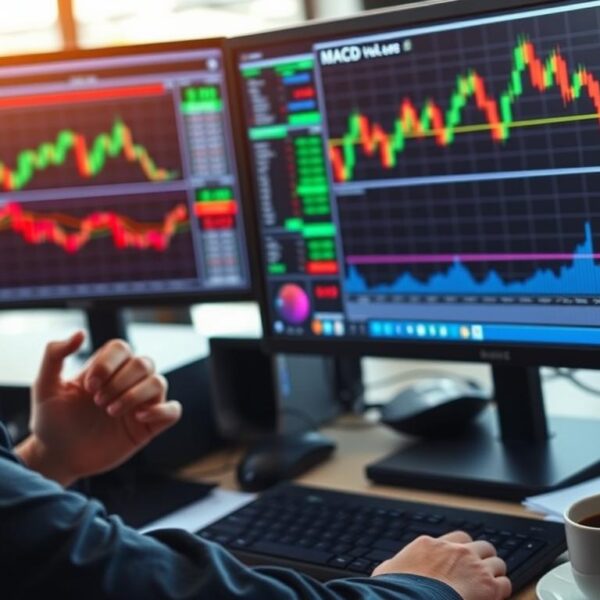The world of trading has undergone a dramatic transformation. Gone are the days of ticker tape machines and exclusive trading floors. Today, investors can buy and sell stocks with just a few taps on their smartphones.
This revolution in investment has been driven by technological advancements, making it possible for millions to participate in the markets. As a result, the finance landscape has changed, presenting new opportunities and challenges.
Understanding this evolution provides valuable insights for modern traders navigating today’s complex markets. This article will explore the key milestones in trading history and how they have reshaped the financial landscape.
Key Takeaways
- The evolution of trading has transformed it from an exclusive activity to a democratized practice.
- Technological advancements have driven this change, making trading accessible to millions.
- The culture of trading has shifted, creating new opportunities and challenges.
- Understanding this evolution is crucial for modern traders.
- The article will trace the journey through key milestones in trading history.
The Birth of Modern Markets: From Ticker Tape to Electronic Trading
From the early days of ticker tape to the sophisticated electronic trading systems of today, the financial markets have undergone a remarkable transformation. This evolution has not only changed how traders operate but has also reshaped the very fabric of the markets.
The Ticker Tape Era: Wall Street’s Original Information System
The ticker tape, introduced in the late 19th century, was the first real-time information system on Wall Street, providing traders with crucial market data. It was a groundbreaking innovation that enabled investors to stay informed about market movements. The ticker tape era was characterized by its mechanical nature, relying on physical machines to print out stock prices and volumes. This system was the backbone of financial information dissemination for decades, playing a critical role in the development of modern financial markets.
The First Electronic Revolution: When Screens Replaced Paper
The advent of electronic quotation systems in the 1960s and 1970s marked the beginning of a new era in financial trading. NASDAQ’s establishment in 1971 as the world’s first electronic stock market was a pivotal moment, eliminating the need for a physical trading floor and paving the way for modern electronic trading. The introduction of electronic trading terminals in the 1980s further accelerated market speeds and transformed broker workflows. Early electronic systems like Reuters and Bloomberg terminals created new information advantages and trading opportunities.
The shift to screen-based trading significantly altered market dynamics, affecting liquidity patterns, price discovery processes, and trading strategies. As electronic markets evolved, they laid the foundation for future innovations, including algorithmic trading, high-frequency trading, and today’s mobile trading platforms. This technological progression has continued to reshape the culture of trading, gradually shifting power from floor traders to those with technological expertise.
Understanding the evolution of financial markets is crucial for investors and traders alike. The transition from physical systems to electronic trading has not only increased the speed of trading but has also opened up new investment opportunities. As the financial landscape continues to evolve, staying informed about market developments and trading strategies is essential for success in the modern financial world.
Market Legends Who Shaped Trading Culture
The history of trading is replete with iconic figures, and Jim Rogers stands out among them for his global macro investment strategies. With a career spanning decades, Jim Rogers has made a name for himself as a pioneer in global macro investing. His insights into emerging markets and global economic trends have been particularly influential.
Jim Rogers: The Global Macro Pioneer
Jim Rogers is renowned for his bold investment strategies, particularly his focus on emerging markets. As a co-founder of the Quantum Fund, Rogers’ investment decisions were closely watched by the financial world. His ability to predict market trends and capitalize on global economic shifts has earned him a reputation as a savvy investor.
Rogers’ investment philosophy emphasizes the importance of understanding global macroeconomic trends. He advocates for a long-term approach to investing, often holding positions for years to capitalize on major economic shifts. This approach has been particularly successful in emerging markets, where Rogers has made significant investments.
Other Influential Traders Who Changed the Game
Beyond Jim Rogers, several other traders have significantly impacted trading culture. Paul Tudor Jones, known for predicting the 1987 crash, is one such figure. His ability to analyze market trends and make accurate predictions has influenced a generation of traders.
George Soros, famous for “breaking the Bank of England,” is another influential trader. His Quantum Fund, co-founded with Jim Rogers, became a powerhouse in global finance. Soros’ trading philosophy, centered around understanding market reflexivity, has been widely studied.
Other notable traders include Jim Simons of Renaissance Technologies, known for revolutionizing quantitative trading, and female pioneers like Muriel Siebert and Linda Bradford Raschke, who broke barriers in a male-dominated industry. The collective contributions of these traders have shaped modern trading culture, introducing new approaches to risk management, market analysis, and trading psychology.
The Evolution of Trading Strategies
The landscape of trading strategies has undergone significant transformations over the years, adapting to technological advancements and market dynamics. Traders have moved beyond traditional methods, embracing new approaches that leverage data analysis and automation.
From Fundamental to Technical Analysis
The early days of trading were characterized by fundamental analysis, where traders relied on financial statements, management team assessments, and industry trends to make investment decisions. As markets evolved, technical analysis gained prominence, with traders using charts and patterns to predict future price movements. This shift was driven by the increasing availability of market data and the development of sophisticated analytical tools.
Technical analysis has become a cornerstone of modern trading, with traders employing various techniques, including trend following and mean reversion strategies. The rise of technical analysis has also led to the development of new tools and indicators, further enhancing traders’ ability to analyze markets. For instance, the use of market insights can provide traders with a deeper understanding of market cycles and trends.
- Technical indicators such as moving averages and Relative Strength Index (RSI) help traders identify potential trading opportunities.
- The integration of technical analysis with other forms of analysis has become increasingly popular, allowing for a more comprehensive view of the markets.
The Rise of Quantitative and Algorithmic Trading
The advent of quantitative and algorithmic trading has revolutionized financial markets. Quantitative strategies, which began gaining traction in the 1980s and 1990s with firms like Renaissance Technologies, involve using mathematical models to identify profitable trades. Algorithmic trading takes this a step further by automating the execution of trades based on predefined rules, allowing for faster and more precise trading.
The rise of high-frequency trading, as exposed in Michael Lewis’s “Flash Boys,” has significantly impacted market microstructure, raising questions about market fairness and the role of technology in trading. Quantitative approaches have evolved from simple statistical arbitrage to complex machine learning models that can process vast amounts of alternative data, enabling traders to make more informed decisions.
The democratization of quantitative tools has also allowed retail traders to implement sophisticated strategies previously available only to institutions. This shift has created new career paths in finance, with mathematicians and computer scientists becoming as valuable as traditional market analysts. As a result, the trading landscape continues to evolve, driven by innovation and the quest for investment insights.
Trading Culture: From Exclusive Clubs to Democratic Access
The trading landscape has undergone a significant transformation, evolving from an exclusive club to a democratized platform. This shift has been driven by technological advancements and changes in market structures, making it possible for a broader range of people to participate in trading.
Breaking Down the Old Boys’ Network
The traditional trading environment was characterized by an “old boys’ network,” where access to market information and trading opportunities was limited to a select few. Trading was once the domain of professionals and wealthy individuals who had the means to access exclusive trading floors and networks. However, with the advent of online trading platforms, this exclusivity has been challenged. The introduction of online brokerages in the 1990s revolutionized market access, allowing ordinary individuals to trade without the need for intermediaries or prohibitive commissions.
Books like Andrew Aziz’s “How to Day Trade for a Living” (2016) and Richard Wyckoff’s “The Day Trader’s Bible” (1919, with revisions in 1999-2001) have also played a crucial role in democratizing trading knowledge. These resources have made it possible for new traders to learn strategies and techniques that were once the preserve of experienced professionals.
Democratization Through Technology
The democratization of trading has been further accelerated by technological advancements, including the development of smartphone trading apps and commission-free trading models. Platforms like Robinhood have pioneered commission-free trading, making it possible for individuals to trade with minimal capital. Social trading platforms have also emerged, creating communities where traders can share strategies and learn from each other.
The benefits of democratized access to trading include greater participation and more diverse market perspectives. However, there are also concerns about inexperienced traders taking excessive risks. As the trading landscape continues to evolve, it is essential for traders to be aware of these risks and to develop strategies that balance potential returns with risk management.
The Digital Revolution: Trading Platforms and Tools
The rise of digital trading platforms and tools has democratized access to the financial markets, enabling traders to make more informed decisions.
Game-Changing Trading Platforms
For beginners, selecting the right trading platform is crucial. The best trading platforms offer a combination of ease of use, robust analytical tools, and reliable customer support. Popular options include Robinhood, known for its commission-free trades, and eToro, which offers a social trading experience. Other notable platforms are Fidelity and Charles Schwab, which provide comprehensive research tools and educational resources.
These platforms have made it easier for new traders to enter the market, offering intuitive interfaces and a range of educational materials to help them get started.
Essential Tools for the Modern Trader
Modern traders rely on a variety of analytical tools to make informed decisions. Basic chart patterns and technical indicators remain essential, while sophisticated screeners help identify potential trading opportunities. Market depth visualization tools have transformed order flow analysis, allowing traders to see supply and demand dynamics in real-time.
Additionally, news aggregation and sentiment analysis tools help traders quickly process market-moving information and gauge market psychology. Backtesting and strategy optimization software enable traders to validate their ideas before risking real capital. Risk management tools have also evolved, helping traders control position sizing, set appropriate stop losses, and manage overall portfolio exposure.
Books like “Trading and Exchanges” by Larry Harris and “Mind over Markets” by James Dalton have provided traders with a deeper understanding of market mechanics and trading strategies, further enhancing their analytical capabilities.
From Wall Street to Social Media: The Rise of Financial Influencers
The rise of social media has transformed the financial landscape, giving birth to a new breed of financial influencers. These individuals have garnered massive followings on platforms like TikTok, Reddit, and Twitter, significantly impacting market trends and investment decisions.
TikTok Traders and Reddit Revolutionaries
TikTok traders and Reddit revolutionaries have become prominent figures in the financial world. They share insights and analysis on various stocks, cryptocurrencies, and trading strategies, often influencing the market with their opinions. For instance, TikTok traders use short videos to explain complex trading concepts, making them accessible to a broader audience. Meanwhile, Reddit communities like r/WallStreetBets have been instrumental in driving the popularity of certain stocks and investment opportunities.
The Impact of Social Media on Market Movements
Social media has accelerated market reactions to news and events, compressing the timeframe in which traders can respond to information. This rapid dissemination of information has led to dramatic price movements in both stocks and cryptocurrencies, often driven primarily by social media attention rather than fundamental changes. For example, the rise of meme stocks and cryptocurrencies represents a new asset class whose value is derived largely from community engagement and social media narratives.
- Sentiment analysis of social media has become a crucial input for algorithmic trading systems seeking to capture alpha from crowd psychology.
- Social media has created new forms of market manipulation concerns, with influencers potentially pumping assets they own without proper disclosure.
- Traditional financial institutions have adapted to the social media era, monitoring platforms for trading signals and insights.
Books like “The Simple Strategy” by Markus Heitkoetter have helped traders develop disciplined approaches to markets increasingly driven by social sentiment and rapid information flow. By leveraging these resources, investors can better navigate the complexities of modern trading and make more informed decisions to manage risk and identify new opportunities for their portfolio, ultimately aiming at making money through day trading.
Conclusion: The Future of Trading in a Connected World
The world of trading has witnessed a profound transformation, evolving from the old ticker tape system to the contemporary TikTok traders. This journey highlights the democratization of trading, where technology has enabled a broader audience to participate in global markets.
Emerging trends such as artificial intelligence, decentralized finance, and increasingly interconnected global markets will shape the future of trading. Despite these advancements, the lessons from Market Legends like Jim Rogers remain relevant, emphasizing the importance of discipline and risk management.
Books like “Thinking, Fast and Slow” by Daniel Kahneman offer valuable insights into the psychological challenges traders face. Additionally, personal development books like “Make Your Bed” and “Happiness” provide wisdom on navigating the emotional aspects of trading. The integration of traditional finance with new technologies is creating hybrid systems that combine institutional expertise with modern accessibility.
In conclusion, the democratization of trading has created both opportunities and responsibilities. It is crucial for traders to emphasize education and discipline in their trading endeavors.








